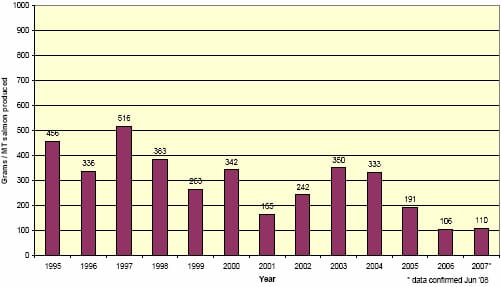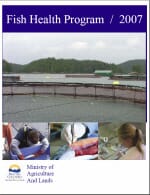An Overview
By way of explanation, all farms categorize their dead fish, giving probable explanation for the losses. A small portion of the routine fish mortality is termed “silvers”. Silvers are fresh carcasses that still have silver skin/scales and died most recently for no apparent reason, or they may show signs of disease.
These mortalities are used as indicators of active disease and reflect the robust production population. They generally represent 25% of the total dead group gathered during an audit. Approximately 10% of this group of silvers is tested by BCMAL for cause of death and specific infectious diseases.
With respect to Atlantic salmon, 78% of the audit cases found few silvers and no infectious disease (at the farm-level). Of the remaining cases, the main disease diagnoses were mouth myxobacteriosis (10%) and bacterial kidney disease (7%). For farmed Pacific salmon, 29% of the audits cases found few silvers and no infectious disease (at the farm-level), and the main disease diagnoses were bacterial kidney disease (47%) and Loma (19%). These diseases are endemic in free-ranging salmon in British Columbia and it is expected that they would be found.
The audit found the same endemic diseases as those reported by industry. The Ministry surveillance program detected no pathogens in farmed salmon that would affect BC or Canadian trade and export.
Antibiotic Use in BC Salmon Aquaculture
1995 -2007

Audits of sea lice abundance at Atlantic farms confirm that the aquaculture industry is complying with the provincial sea lice management strategy. In 2007, BCMAL conducted lice counts at 57 farms and assessed 3,380 live fish. Lice abundance triggers, established to guide the management of sea lice, were introduced and fully implemented in 2004 after examining the data available in the published literature and from governments of other provinces and countries.
To date, trigger levels of three motile lice per fish continue to be viewed as rational and precautionary for lice management. The latest genetic research (by Yazawa et al., 2008) has the potential to influence management strategies in that his findings appear to offer a plausible explanation as to why Atlantic salmon in British Columbia show little or no outward signs of ill health from Pacific sea lice.
The Ministry’s Fish Health Program provides regulators with a comprehensive understanding of the health status of fish stocks on salmon farms. The program supports the monitoring, reporting, and regulation of fish disease, and addresses health concerns that may arise in farmed fish. The annual Fish Health Report summarizes the information generated by the program for the calendar year.
Summary and Conclusions
Since 2003 the BCMAL fish health program has provided an overview of the health of salmon on fish farms in British Columbia and provides regulators an avenue to enforce disease management on the farms. The Fish Health Management Plan requires marine salmon farmers to report fish health events, mortality rates and causes, and sea lice abundance.
The 2007 audit and surveillance data indicate that disease, when detected on salmon farms in British Columbia, is of a type that is natural to the marine region and has generally been previously identified in free-ranging wild Pacific salmon. Brains and pyloric caeca from silver carcasses were recently added to the tissues submitted for histological assessment and this change allowed an improvement in diagnosis of cause of death.
Two marine parasites found in the brains of a limited number of Atlantic salmon carcasses in 2007 are of scientific interest and contribute to the information derived from surveillance efforts. These parasites may represent the emergence of an indigenous pathogen worthy of close monitoring and further investigation however there is no evidence that they are exotic to British Columbia.
The objective of the sea lice audit is to ensure that on-farm counting protocols are followed and to verify the state of lice infestations on BC salmon farms. The industry has embraced the sea lice management strategy and full compliance with the Ministry’s requirements for monitoring occurs. Overall, lice abundance on Atlantic salmon farms in 2007 was the lowest on record with averages in most regions being well below the three motile lice per fish.
Salmon begin their life cycle in fresh water where they are free of sea lice. After being transported to marine farms, lice infestations arise as a result of exposure to sea lice from wild salmon and other marine fishes. Atlantic salmon are known to be one of the most susceptible fishes to sea lice infestation; thus, farmed salmon serve as the appropriate sentinel population in British Columbia to monitor abundance. The Province continues to work with Fisheries and Oceans Canada, other researchers and the Pacific Salmon Forum to monitor sea lice and to integrate new information into lice control strategies.
The Province is committed to continued improvement to the Fish Health program through integration of sound scientific information. This will ensure that the aquaculture sector of British Columbia remains productive and environmentally sustainable, while continuing to achieve the highest standards of sea food quality and wholesomeness through fish health management.
Further Reading
| - | You can view the full report by clicking here. |
September 2008


